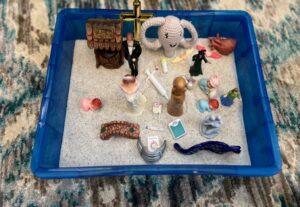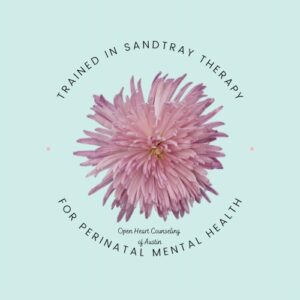Healing Trauma Without Words.
You’ve done the work-talked it through, tried the tools, sat through the sessions.
And still, something feels….stuck.
The sadness won’t leave…
The fog won’t clear…
The peace you’re reaching for feels just slightly out of reach.
Trauma has a way of burrowing deep into the brain.
Even when you can’t find the words, your body still holds the story.
When talk therapy isn’t enough, sandtray offers another way forward.
You might be wondering: “You want me to play with sand and tiny toys? Isn’t that just for kids?”
Actually, sandtray is for everyone-children, teens, adults. It’s not about playing. It’s about processing and healing the parts of your story that words alone can’t touch.
What is Sandtray Therapy?
Sandtray therapy uses miniature figures, symbols, and sand to create a visual story-a reflection of your inner world. It taps into both the right and left sides of your brain, giving language to emotions and experiences that are too complex, painful, or pre-verbal to explain with words.
Combine this with EMDR therapy, and you’ve got something potent. **Chef’s kiss. **
Alice: Grief and Healing After Loss
After losing her husband of 24 years, Alice felt like the world had gone quiet. The doctor’s words echoed in her mind. She didn’t know how to move forward—until she found sandtray therapy.
At first, skeptical. But by session five, she let her heart and brain guide her.
With each miniature placed in the sand, her grief found a voice.
With EMDR and sandtray, Alice healed—body, mind, and soul.
“I didn’t know how much I needed to tell my story until I could see it in the sand.”
Sarah: The Motherhood She Didn’t Expect
Sarah thought motherhood would bring joy. Instead, it brought overwhelm, confusion, and guilt.
Through sandtray, she built scenes of what she hoped motherhood would be—beside what it really was.
This visual exploration helped her shed shame and embrace her evolving identity as a mother.
“Sandtray helped me realize I wasn’t failing—I was adjusting. And that was enough.”
Kate: The Body Remembers
Chronic pain plagued Kate. Doctors said it was all in her head.
But her body told a deeper story—a childhood trauma left unspoken.
Sandtray helped her see what words couldn’t describe.
With each tray, she moved closer to healing—both emotional and physical.
“For the first time, I didn’t feel broken. I felt seen.”
Why Sandtray Works
- Right-brain healing: trauma is often stored in images and sensations, not words.
- Safe symbolic distance: see your story without reliving it.
- EMDR integration: unlock deeper healing and nervous system regulation.
- Non-verbal expression: for when words are too much—or not enough.
FAQ About Sandtray
Can sandtray therapy be done virtually?
Yes. While in-person is preferred, online sandtray platforms can offer a similarly transformative experience.
What’s the difference between sandtray, sandplay, and play therapy?
- Sandplay is rooted in Jungian theory and typically non-directive.
- Play therapy focuses on children’s emotional processing through play, which may or may not involve sand.
- Sandtray therapy is directive and often used alongside other therapies like EMDR.
Ready to See What the Sand Can Show You?
Whether you’re navigating grief, trauma, identity shifts, or chronic emotional fatigue—sandtray therapy offers a new way in.
Gentle. Powerful. Transformative.


 ute consultation:
ute consultation: